Prokaryotic Cells
Prokaryotic cell meaning: Prokaryotic cells are defined as small, unicellular organisms that lack a nucleus and membrane-bound organelles. They are generally found in the Monera and Protista kingdoms. Prokaryotic cells is a topic of the chapter Cell: The Unit of Life in Biology.
What is a Prokaryotic Cell?
Prokaryotic cell definition: A prokaryotic cell is a single-celled organism without a true nucleus or other membrane-bound organelles, usually found in bacteria and archaea.
Prokaryotic cells are defined by their simplicity, their genetic material being put not inside a nuclear envelope but into a nucleoid area.
They have a cell membrane, cytoplasm, ribosomes, and sometimes a cell wall.
Prokaryotic cells lack membrane-bound organelles such as mitochondria or endoplasmic reticulum.
The DNA is generally one circular chromosome; some may also contain plasmids, small, circular DNA molecules that can be transferred from one cell to another.
Don't Miss: Most scoring concepts for NEET | NEET papers with solutions
NEET 2025: Syllabus | PYQs | Crack NEET in 2 months - Study Plan
NEET Important PYQ & Solutions: Physics | Chemistry | Biology | NEET PYQ's (2015-24)
- What is a Prokaryotic Cell?
- Characteristics of Prokaryotic Cells
- Functions of Prokaryotic Cells
- Reproduction in Prokaryotes
- Mechanisms of Genetic Exchange
- Roles of Prokaryotes
- Differences Between Prokaryotic and Eukaryotic Cells
- Applications of Prokaryotic Cells
- Recommended video for "Prokaryotic Cells"
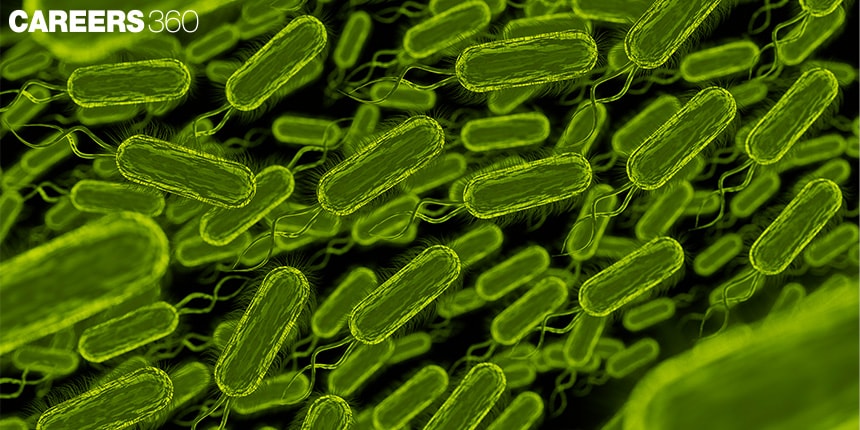
Characteristics of Prokaryotic Cells
They lack a nuclear membrane.
The genetic material is present on a single chromosome.
Histone proteins are absent.
The cell wall is made up of amino acids and carbohydrates.
Divide asexually by binary fission and sexually by recombination.
The plasma membrane acts as the mitochondrial membrane, carrying respiratory enzymes.
Other Characteristics are:
Simple Structure
Prokaryotic cells are the very basic and simple forms of life. All the complex structures found in eukaryotic cells are absent here, which makes the prokaryotic cells simple and small. Although simple compared with eukaryotic cells, prokaryotic cells do work well and are skilled in performing all life functions.
Lack of a True Nucleus
A prokaryotic cell lacks a nucleus. In place of the nucleus, it is characterised by the presence of a nucleoid region that does not have a limiting membrane, and in prokaryotes, the DNA is generally one singular, circular chromosome that occurs in free space within the cell.
Absence of Membrane-bound Organelles
One of the crucial distinguishing features of prokaryotic cells is that they lack membrane-bound organelles. Such membrane-bound organelles, typical in eukaryotic cells, such as mitochondria, endoplasmic reticulum, and Golgi apparatus, do not exist in prokaryotic cells. They carry out all their cellular activities either in the cytoplasm or at the membrane.
Small Size
Generally, size-wise, the prokaryotic cells are very small compared to the eukaryotic cells and range in size from 0.1 to 5.0 µm in diameter. This small size permits a greater surface area-to-volume ratio that speeds up nutrient uptakes and waste removal.
Comparison with Eukaryotic Cells
Prokaryotic cells are far simpler than eukaryotic cells, lacking most of the structural features that define eukaryotes. Eukaryotic cells have a defined nucleus, are mostly linear chromosomes, and have great structural diversity because of the compartmentalization of different cellular processes with different organelles. The differences between these two different cell forms highlight the achievement of increasing complexity through evolution and the differentiation of higher organisms.
Types of Prokaryotic Cells
The types of prokaryotes are:
Bacteria
Bacteria are one of the two superkingdoms of prokaryotic cells. They can be found in almost every habitat on Earth - from soil to water to air, and even in and on our bodies. Bacteria are of tremendous importance to most ecosystems because they participate in the earth's element cycling, such as nitrogen and carbon cycles, and elements such as phosphorus, sulfur, and iron are just a few examples. They occur in several shapes, such as cocci (spherical), bacilli (rod-shaped), and spirilla (spiral-shaped). Some examples of prokaryotic cell are include Salmonella, Cyanobacteria, Streptococcus, etc.
Archaea
Archaea is the other half group of prokaryotic cells, apart from bacteria. They are similar to bacteria in that they are unicellular, and neither have a membrane-bound nucleus nor organelles. However, a significant difference between archaeans from bacteria is about genetic makeup and biochemistry. Archaea usually resides in extreme conditions like very high or low temperatures, high salinity, high pressure, and low oxygen. They are known to thrive under diverse environmental conditions.
Prokaryotic Cell Structure
The prokaryotic cell structure includes:
Cell Wall
Primarily composed of peptidoglycan (in bacteria).
Provides structural support and protection.
Maintains the shape of the cell.
Plasma Membrane
Consists of a lipid bilayer with embedded proteins.
Controls the passage of substances in and out of the cell.
Site of many metabolic activities.
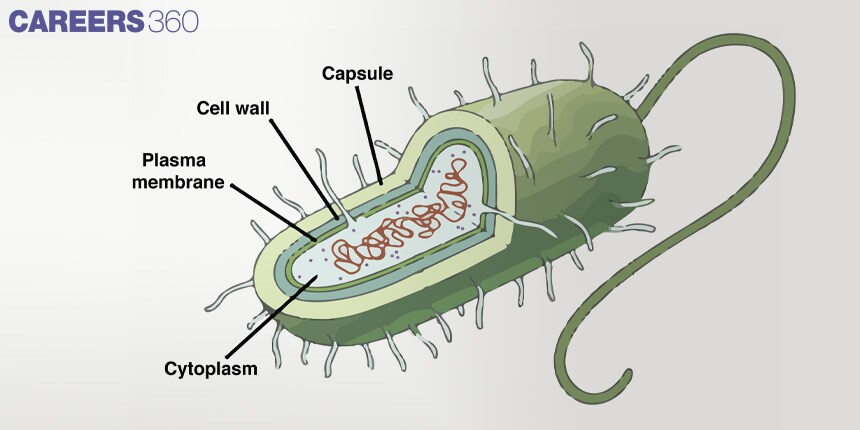
Cytoplasm
Contains the cytosol, ribosomes, and genetic material.
Site of metabolic processes and biochemical reactions.
Suspend cell structures and have a role in moving materials within the cell.
Nucleoid
Region in the cytoplasm where the cell's DNA is located.
Contains a single, circular chromosome.
Responsible for storing and transmitting genetic information.
Plasmids
Small, circular DNA molecules are found in the nucleoid.
Carries additional genes—genes for antibiotic resistance are an example.
Can be transferred between cells; they often carry non-crucial genes.
Ribosomes
Composed of an RNA and several proteins.
Are smaller in size compared to eukaryotic ribosomes (70S).
Are the sites of protein synthesis
Pili and Fimbriae
Hair-like appendages are found on the surface of the cell.
Involved in DNA transfer from one cell to another during conjugation.
Involved in attachment to surfaces and other cells
Flagella
Flagella is a long, whip-like structure.
Provides motility through a rotary motion.
Allows the cell to move in a favourable environment and away from a potentially harmful one.

Also Read-
Functions of Prokaryotic Cells
Normally, prokaryotic cells reproduce by binary fission, asexual reproduction where one single cell divides to give two daughter cells, and both are genetically identical to the parent.
In this way, the tiny organism can multiply quickly and remain genetically invariant over generations.
The process in which two new cells develop begins with DNA replication and is followed by cytoplasm and cell membrane division.
The metabolism in prokaryotic cells includes the process through which energy is produced or cellular respiration.
The process can be either aerobic or anaerobic, and its purpose is to convert glucose into ATP. Fermentation, on the other hand, is anaerobic; it achieves glucose breakdown into energy without oxygen and creates certain byproducts, such as lactic acid or ethanol.
There also exist many ways of obtaining nutrients by prokaryotic cells. Some of these organisms are photosynthetic in certain cyanobacteria and chemosynthesis in particular archaea, enabling them to inhabit a huge range of habitats.
Genetic exchange among prokaryotes occurs through three principal mechanisms: conjugation, transformation, and transduction.
The transfer of genetic material between two bacterial cells that are temporarily joined. Transformation is the uptake of free DNA by a bacterium from its surroundings, and transduction is a method of genetic recombination in bacteria that requires a bacterial virus to carry bacterial DNA from donor to recipient; these processes contribute to genetic variation and are paramount to widespread prokaryotic adaptation and speciation.
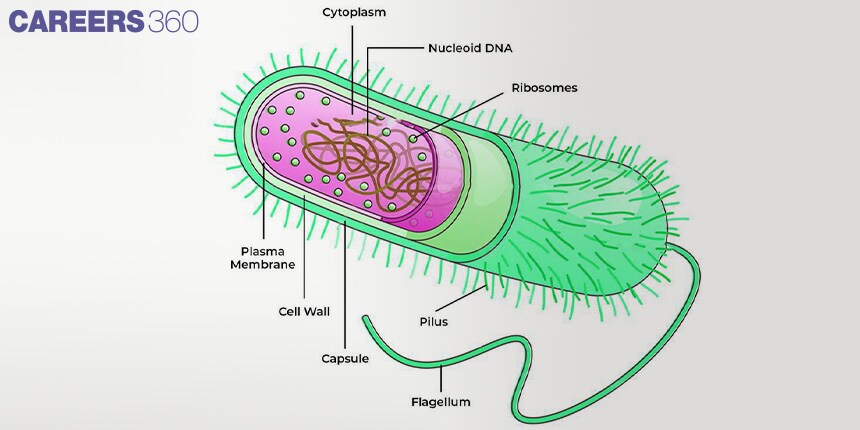
Reproduction in Prokaryotes
- Prokaryotic cells reproduce primarily through binary fission, an asexual process where a single cell divides into two genetically identical daughter cells. This simple and efficient process of reproduction permits fast growth in this kind of cell, especially when conditions are right. The process usually initiates with the replication of the cell DNA, which consequently assures that both daughter cells receive the same genetic material.
- Binary fission takes place in several stages: the cell enlarges, the DNA is replicated, and the two identical copies are attached to different regions of the cell membrane. The membrane grows inwards at the centre, dividing the cell into two. Finally, the cell membrane and wall divide the original cell in half, and two daughter cells result, each having the complete genetic material of the original cell.
- In addition to binary fission, prokaryotes can share genes across individual cells with a process called conjugation, which some scientists refer to as a form of sexual reproduction.
In conjugation, two prokaryotic cells can get interconnected across cytoplasmic bridges, where one cell wholly or partially donates a section of its DNA to the other cell. Thus, increasing the opportunity for genetic distribution and also through the horizontal transfer of specific traits to adjacent cells, such as antibiotic resistance.
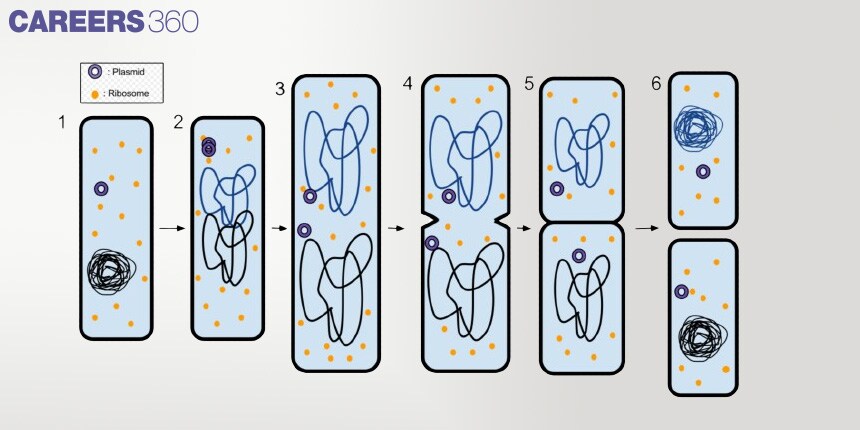
Mechanisms of Genetic Exchange
The mechanism is described below:
Conjugation
It is a method in which there is a direct transfer of DNA from one prokaryotic cell to another such, that a pilus physically connects the two. This gives one cell the ability to offer its plasmid or a small piece of chromosomal DNA to another cell, thus enhancing genetic variation.
Transformation
This mechanism involves the uptake of free DNA fragments from within the environment by a prokaryotic cell. This DNA is often that of lysed cells and may be integrated into the recipient cell's genome, leading to new genetic traits.
Transduction
This transfer of genetic material between bacteria results from an accident by bacteriophages, a set of viruses infecting bacteria. Bacteriophages take up a fragment of the host bacterium's DNA during an infection and then bring such genetic material to another bacterial cell, thus promoting genetic exchange.
Roles of Prokaryotes
The roles of prokaryotes are:
Decomposers
Prokaryotic cells, especially bacteria, are the chief decomposers in the ecosystem. They break down dead organic materials, thus recycling nutrients back into the environment. This in effect helps nutrients be retained in the soil, which maintains soil fertility and promotes plant growth, which is good for the whole ecosystem. Some examples of prokaryotic cells are- E.coli, streptococcus, etc.
Nitrogen Fixation
Certain prokaryotes, such as cyanobacteria and rhizobia, can fix nitrogen. They change the atmospheric nitrogen to forms that are useful to plants. Nitrogen, required for growth, is one of the principal components of proteins and nucleic acids of many plants. The use of nitrogen-fixing prokaryotes is critical in agriculture to improve the health of soils besides improving productivity.
Pathogens
Several prokaryotic cells are pathogenic and they become the cause of various diseases in mammals, plants, and others. Escherichia coli and Mycobacterium tuberculosis are some of the bacteria that cause severe infection. This knowledge of these pathogenic bacteria is essential in the development of antibiotics, vaccines, etc., to serve the counter diseases caused by various pathogenic micro-organisms and to ensure human health.
Symbiotic Relationships
Prokaryotes are involved in many different types of symbiotic relationships: mutualism, commensalism, and parasitism. In a mutualistic relationship, both organisms benefit, for example, the gut microbiota of man. Commensalism is meant to include the situation where one organism benefits from the other's neutral position, and parasitism is meant to define the relationship in which one benefits from the other's cost. The interactions bring out the different roles and contributions to ecosystems that are very diverse and very crucial.
Differences Between Prokaryotic and Eukaryotic Cells
Prokaryotic and eukaryotic cells are differentiated on the following basis:
Structural Differences
Prokaryotic cells do not have well-defined nuclei, in contrast to eukaryotic cells, which have a membrane-bound nucleus.
There are no membrane-bound organelles in prokaryotic cells, whereas eukaryotic cells have membraned organelles, including mitochondria, endoplasmic reticulum, and Golgi apparatus.
Bacteria are generally smaller and range from 1 to 10 micrometres, as compared to eukaryotic cells, which span from 10 to 100 micrometres.
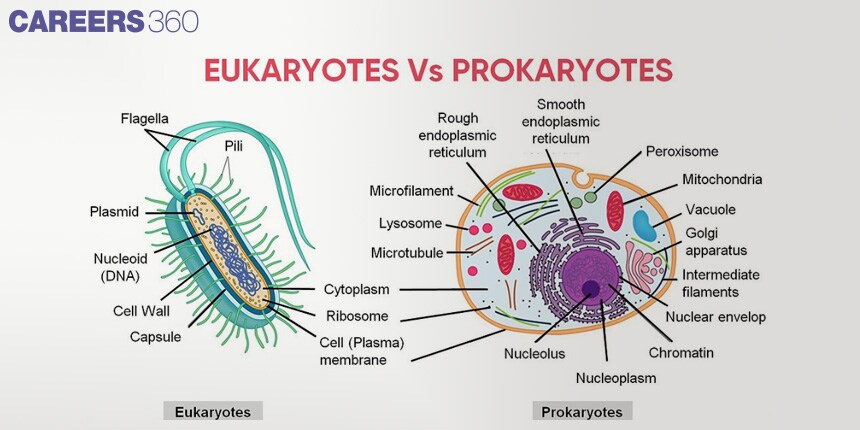
Reproductive Difference
Prokaryotic cells undergo asexual reproduction by binary fission.
Eukaryotes are cells characterised by their ability to reproduce through the process of mitosis for growth and repair and meiosis for sexual reproduction.
Genetic Differences
Prokaryotic cells contain only one circular DNA molecule within the nucleoid region, and eukaryotic cells contain several linear chromosomes present in the nucleus.
Applications of Prokaryotic Cells
In biotechnology, prokaryotic cells have been put to an array of uses in genetic engineering for the production of proteins, enzymes, and other valuable products. Bacteria, for example, are genetically engineered to manufacture insulin and other medicinal products. Conversely, in the production of antibiotics, their derivation from the natural metabolism of some bacteria comes in handy. This biotechnological role is a clear pointer to the vast importance of prokaryotes in medicine and industry.
Environmental applications entail the use of prokaryotic cells in bioremediation-modified treatment processes. Non-prokaryotic cells remove environmental pollutants through bioremediation. The cells degrade the dangerous components to less harmful ones. Prokaryotes will also come in handy in waste treatment processes that deal with the degradation of the organic matter in sewage, thus contributing to the development of more sustainable ways of taking care of waste.
Prokaryotic cells assume a crucial role in medical research-modified treatment methods. They can be the basis for developing vaccines against bacterial agents and used to uncover the mysteries of pathogenesis to develop new treatments. For example, pathogenic bacteria, by being studied, can help scientists devise vaccines for bacterial infections or even explain bacterial apparatuses for developing new treatments. This is basically how important prokaryotic cells are for medical science and the general health benefit.
Also Read-
Recommended video for "Prokaryotic Cells"
Frequently Asked Questions (FAQs)
Prokaryotic cells represent unicellular life forms that are relatively simple and devoid of true nuclei and membraned organelles. They encompass the domains of Bacteria and Archaea.
Among the abundant differences between prokaryotic and eukaryotic cells are the prokaryotic cells' nonexistence of a nucleus and other membranous organelles and their comparatively smaller size. Eukaryotic cells, in contrast, possess a membrane-bound nucleus, and many membrane-bound organelles, and are structurally larger.
Basic cell structure is shared among the domains of Bacteria and Archaea. The two types of prokaryotic cells are members of the domains Bacteria and Archaea.
Unicellular prokaryotes reproduce asexually, by binary fission or another method, but may also exchange genetic material through a process of horizontal gene transfer, in which genetic material from one cell is taken up by another cell of the same generation.
Prokaryotic cells carry out the essential processes of life, including metabolism, signal transduction, and cell differentiation.
Also Read
27 Dec'24 05:51 PM
23 Nov'24 05:46 PM
08 Nov'24 05:04 PM
08 Nov'24 10:59 AM
08 Nov'24 09:54 AM
08 Nov'24 09:26 AM
08 Nov'24 09:01 AM
07 Nov'24 10:17 PM
07 Nov'24 09:50 PM
07 Nov'24 04:38 PM